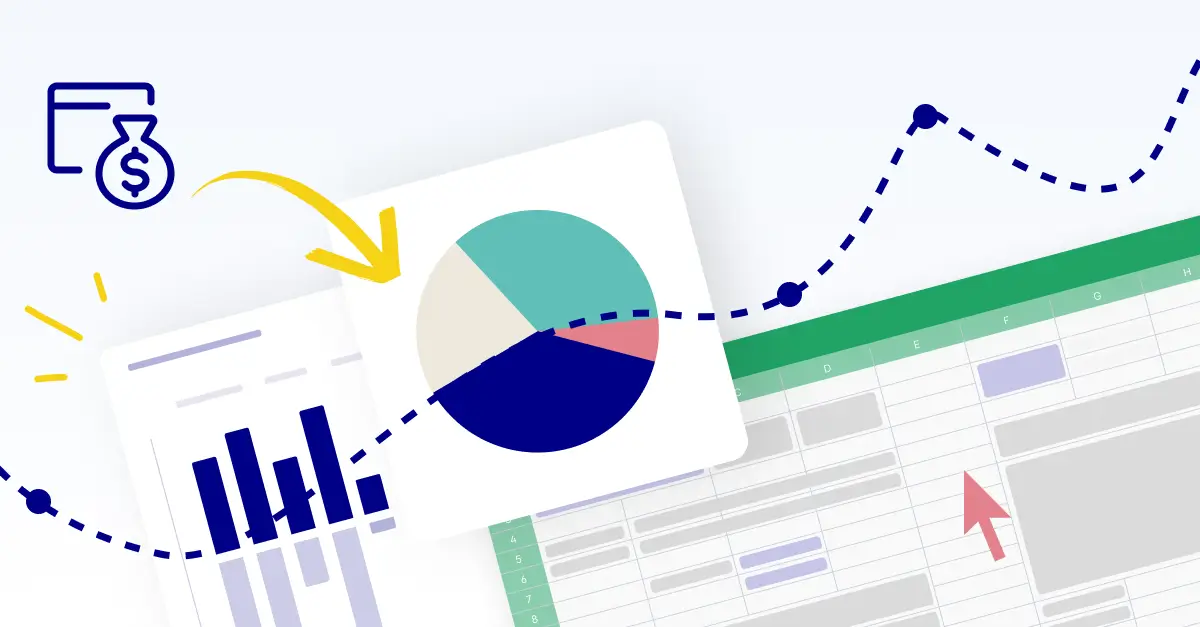Finance leaders know that analyzing variances isn’t just about crunching numbers, it’s about uncovering why performance differs from expectations and using those insights to make sharper decisions. Done right, variance analysis provides visibility into budgets, forecasts, and actual results, helping teams stay proactive instead of reactive.
Deloitte’s Q2 2025 CFO Signals report shows CFO sentiment is cautious due to economic uncertainty, with internal risks like lack of agility and resilience cited by 46% of CFOs.
This demonstrates the high importance CFOs place on agility and the need for tools like advanced variance reporting to manage unpredictability. Templates streamline this process by giving finance teams structured, repeatable ways to evaluate differences in revenue, expenses, cash flow, and more.
What Is a Variance Analysis Template and Why Is It Essential?
A variance analysis template is a structured financial tool that helps teams compare planned performance (budgets or forecasts) against actual results. Instead of manually building reports from scratch each time, templates provide a repeatable framework that organizes data into clear categories like revenue, expenses, margins, or cash flow.
Why It’s Essential?
- Saves Time: Templates eliminate repetitive setup work, allowing finance teams to focus on analysis rather than formatting.
- Improves Accuracy: Standardized structures reduce errors and ensure consistent reporting across departments.
- Enhances Agility: With markets shifting rapidly, templates help CFOs and analysts quickly spot trends and react.
- Supports Transparency: Makes it easier to communicate financial performance to stakeholders with clarity.
- Drives Strategic Insights: By highlighting variances, teams can uncover inefficiencies, identify opportunities, and make informed decisions.
In a climate where agility is critical, variance analysis templates are more than just reporting tools; they’re essential for keeping organizations financially resilient.
Best 9 Variance Analysis Templates You Can Start Using Today
Variance analysis is most powerful when applied across multiple aspects of financial performance. A single template won’t give you the whole picture — which is why high-performing finance teams use a suite of variance tools to evaluate revenue, costs, margins, and liquidity. Each template brings unique insights, helping leaders not only identify problems but also understand their root causes and take corrective action.
Here’s a deep dive into the 9 most effective variance analysis templates every finance team should be using:
1. Budget vs. Actual Template
This is the foundation of all variance reporting. It compares what was planned (the budget) to what actually happened. Any deviation, whether positive (favorable) or negative (unfavorable), is immediately visible.
- Why it matters: Reveals whether the organization is operating within its financial plan.
- Example: Marketing was budgeted $50,000 for Q1 but spent $65,000. The $15,000 unfavorable variance prompts a review of overspending.
- Best for: Monthly or quarterly reviews to track discipline against budgets.
2. Forecast vs. Actual Template
Budgets are often fixed annually, but forecasts adjust as conditions change. This template compares rolling forecasts to actual results to measure how well assumptions hold up.
- Why it matters: Improves forecasting accuracy by learning from past errors.
- Example: A sales forecast predicted $500,000 in revenue for June, but actuals were $450,000. This variance signals overestimation of demand.
- Best for: Organizations that rely on dynamic planning and quarterly updates.
3. Revenue Variance Template
Revenue isn’t just about the total number, it’s about understanding where changes come from. This template breaks down revenue variances by volume, price, product mix, or geography.
- Why it matters: Clarifies whether sales quantity, pricing strategies, or market shifts drive performance changes.
- Example: Revenue is below target, not because fewer units were sold, but because heavy discounts lowered average selling prices.
- Best for: Sales-driven organizations needing visibility into pricing vs. volume drivers.
4. Expense Variance Template
Tracks operating expenses like payroll, utilities, rent, and marketing to flag over- or under-spending.
- Why it matters: Helps control costs and ensures departments are accountable for spending decisions.
- Example: Payroll costs exceed budget due to overtime expenses, signaling staffing inefficiencies.
- Best for: Department-level variance reviews to maintain budget discipline.
5. Sales Volume Variance Template
Explains whether revenue variances are due to changes in units sold or price fluctuations.
- Why it matters: Tells you if a revenue shortfall is demand-driven or pricing-driven.
- Example: A 10% decline in sales volume at the same price point indicates reduced market demand rather than pricing issues.
- Best for: Sales strategy, demand planning, and product positioning.
6. Cost of Goods Sold (COGS) Variance Template
Production costs often fluctuate due to raw materials, labor, or supply chain dynamics. This template identifies where those changes occur.
- Why it matters: Protects profit margins by revealing inefficiencies or cost pressures early.
- Example: Raw material costs rise by 12% above budget, cutting into margins unless pricing adjustments are made.
- Best for: Manufacturing, retail, and product-heavy businesses.
7. Profit Margin Variance Template
A holistic template that links revenue and expense variances to explain why margins are higher or lower than expected.
- Why it matters: Profitability is the ultimate measure of financial health, and this template pinpoints what’s driving it.
- Example: Revenue increased, but profit margins declined due to a spike in promotional spending.
- Best for: Executive reports, investor presentations, and strategic planning.
8. Cash Flow Variance Template
Goes beyond profitability to analyze whether cash inflows and outflows match expectations.
- Why it matters: A business can show profits but still face liquidity issues. This template ensures solvency.
- Example: A positive profit margin but negative cash flow variance due to delayed customer payments.
- Best for: Treasury teams managing liquidity and short-term funding.
9. Departmental Variance Template
Provides variance insights at the department or cost-center level, empowering managers to take ownership of financial performance.
- Why it matters: Decentralizes accountability and ensures financial discipline across the organization.
- Example: HR exceeded budget due to unplanned training programs, while IT stayed under budget by delaying system upgrades.
- Best for: Mid-to-large enterprises with multiple cost centers.
Each of these templates addresses a unique dimension of financial performance. Used together, they create a holistic system of analysis that improves accuracy, agility, and accountability across the organization.
How to Choose the Right Variance Analysis Template
With so many templates available, finance teams need to pick the ones that align best with their goals, industry, and reporting needs. Here’s how to narrow it down:
- Start with Budget vs. Actual
- If your team is new to variance analysis, this is the essential baseline. It gives a clear view of how spending and income align with the original budget.
- If your team is new to variance analysis, this is the essential baseline. It gives a clear view of how spending and income align with the original budget.
- Use Forecast vs. Actual for Agility
- For organizations in fast-changing industries (like tech or retail), this template ensures rolling forecasts remain accurate and responsive.
- For organizations in fast-changing industries (like tech or retail), this template ensures rolling forecasts remain accurate and responsive.
- Prioritize Revenue and Sales Variance Templates if Growth Is the Focus
- If leadership is tracking aggressive growth targets, focus on revenue drivers like pricing, volume, and product mix.
- If leadership is tracking aggressive growth targets, focus on revenue drivers like pricing, volume, and product mix.
- Lean on Expense and COGS Variance if Cost Control Is Critical
- For businesses under margin pressure, these templates highlight where overspending or supply chain issues erode profitability.
- For businesses under margin pressure, these templates highlight where overspending or supply chain issues erode profitability.
- Rely on Profit Margin and Cash Flow Templates for Executive-Level Reporting
- These high-level templates are best for C-suite and investors, showing not just performance but also sustainability.
- These high-level templates are best for C-suite and investors, showing not just performance but also sustainability.
- Deploy Departmental Variance Templates for Accountability
- In larger organizations, this helps department heads own their financial results and stay within spending boundaries.
Pro tip: Most finance teams benefit from using at least 3–4 templates together, one for overall visibility (Budget vs. Actual), one for accuracy (Forecast vs. Actual), and one each for revenue and cost focus.
Final Thoughts
Variance analysis is more than a reporting exercise; it’s a discipline that empowers finance teams to understand performance, anticipate risks, and act with confidence. Whether it’s spotting budget overruns, fine-tuning forecasts, or protecting margins, the right templates make the process faster, more accurate, and easier to scale across departments.
By adopting these 9 variance analysis templates, finance teams can replace reactive number-crunching with proactive financial management. In today’s uncertain business environment, having structured, repeatable tools isn’t just convenient, it’s essential for agility, accountability, and long-term growth.





